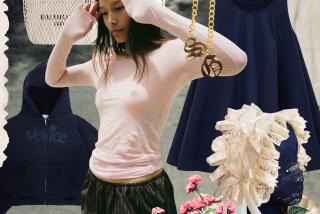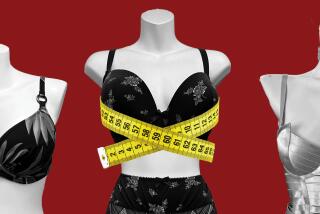Fashion 88 : Maternity Wear Has a Before and After
- Share via
Tall, slim Dana Rosen wears only maternity clothes, but she hasn’t been pregnant for several years. Likewise, Size-4 Terry Williams works in maternity clothes every day, but she isn’t expecting. And although Ziza Elrod Brown’s trendy outfits would fit a pregnant woman through full term, she just likes soft, billowy styles.
All three women are in the maternity business and they’re proving a point: Maternity clothes should have life after birth.
“When a woman spends $250 on a dress,” explains Rosen, co-founder with husband Marcello of A Pea in the Pod stores, “she should be able to wear it longer than four or five months.
“She should be able to think of it as any other new addition to her wardrobe,” says Rosen, whose new Beverly Hills store is the 10th in their chain. “Something she can wear for as long as she wants, not just while she’s pregnant.”
With that concept in mind, designers and retailers are taking a new approach to maternity clothes. They are creating and selling garments that look as good on a woman after the baby is born as they do before. Forget old-fashioned smocks and Helanca-nylon stretch panels. New Age maternity garb is as stylish as any other ready-to-wear--just roomier.
Brown, co-founder of Baby Boom Boom, the new Beverly Hills maternity and baby boutique, says she sells clothes that don’t contribute to postpartum depression.
“Why would a woman want to buy clothes that are just meant for pregnancy? Why not offer her something that’s festive and looks wonderful whether she’s pregnant or not?”
How a garment will look on a woman who isn’t pregnant gets almost as much thought as how it will look when she’s in full bloom, Williams, a former retailer who now designs the Isis maternity collection, explains.
“Nobody can believe that the clothes I wear are for maternity--and that’s how it should be. A woman should not feel that she has to compromise on style just because she’s going to have a baby.”
To accommodate a baby bulge, several extra inches of fabric go into a maternity outfit, especially from the bust to the hips. But, as Williams points out, in most cases “the shapes are still flattering afterward. Some women add belts to define the waist, but often they just wear the outfit as is.” She adds that most hemlines need adjustment, because maternity clothes are cut a bit longer in front.
At Baby Boom Boom, an alterations lady is on staff to taper clothes after the birth.
Selling mostly one-of-a-kind designs, Brown and her Boom Boom partner, Leslie Bohn, carry merchandise made for non-pregnant women, then ask designers to adjust the patterns to make room for baby. Pants that are made larger through the hips and waist can be re-altered for regular wear.
Telltale signs of old-fashioned maternity clothes are gone. In place of little-girl collars and babyish appliques are more sophisticated and updated design details, such as pouf skirts and peplums. Black shows up as often as pastels. And these days, it’s difficult to find skirts and pants with the nylon inserts that stretch as the months pass.
“Unnecessary,” Williams says. “Clothes can be constructed to accommodate a 30- or 40-pound weight gain without shouting ‘maternity.’ ” She demonstrates elastic waistlines, pleated treatments and half belts that expand as the waist gets bigger and contract when baby’s in the bassinet.
Most pregnant women look forward to switching back to their normal wardrobe. “They’re sick of wearing maternity clothes--no matter how great they look,” says Eddie Bledsoe, who designs Edgar, a maternity sportswear collection.
“Unfortunately, most pregnant women don’t realize that they won’t fit into their regular things for several weeks or months. That’s when they’re grateful for styles that don’t look like maternity clothes.”
Geraldine Warner, who owns 10 Today’s Maternity stores in California, says she prefers to sell items that women can wear for about six months after the pregnancy.
“Their first priority is comfort--not whether or not they can wear something afterward,” she says. But, “once they realize that their regular skirts and pants don’t fit after the baby is born, then they pull out the maternity clothes and reconsider them.”
Bobbie Arnel, buyer for Saks Fifth Avenue’s maternity department, says 60% of her sales are in two-piece outfits. “During a pregnancy, many women find that two-piece sets are more versatile. Afterward, the top works with regular pants and skirts. My customer wants to be able to get her money’s worth.”
Arnel says it’s not unusual for a woman to spend $2,000 on an initial maternity wardrobe “and add pieces if she gets bored.”
At A Pea in the Pod, Rosen says a client may spend $3,000 to $5,000 over the course of the nine months--”but she knows she’s going to wear most of it afterward.”
It’s working women who spend the most on maternity clothes, according to Pauline Wallis, co-owner of Reborn Maternity, a New York-based chain
with stores in Lawndale and Sherman Oaks. The New York store also does a thriving mail-order business.
“Women who are in the workplace every day don’t want to feel like they’re wearing the same thing over and over again, so they tend to invest in a wide selection of clothes,” Wallis says.
Designing clothes for postpartum wear augments their appeal and induces women to spend more. “One woman spent $1,600 by mail order,” Wallis says.
This spring, maternity styles feature the same variety of lengths and shapes as regular ready-to-wear collections. The miniskirt is available, Wallis says, but is being outsold by below-the-knee lengths--a buying trend apparent in non-maternity departments as well.
Polka dots and bow trims are popular among the trendy set, according to Arnel.
Warner and Rosen agree that cotton knit is the most versatile--and popular--fabric for wear before and after birth.
Despite the efforts of designers and retailers, there are still those women who can’t wait to ditch their maternity duds as soon as their figures allow. Thrift shops and newly pregnant friends wait for them with open arms.
And for the woman who won’t give away a $200 dress--but can’t stand the sight of it--Baby Boom Boom has a resale rack.






